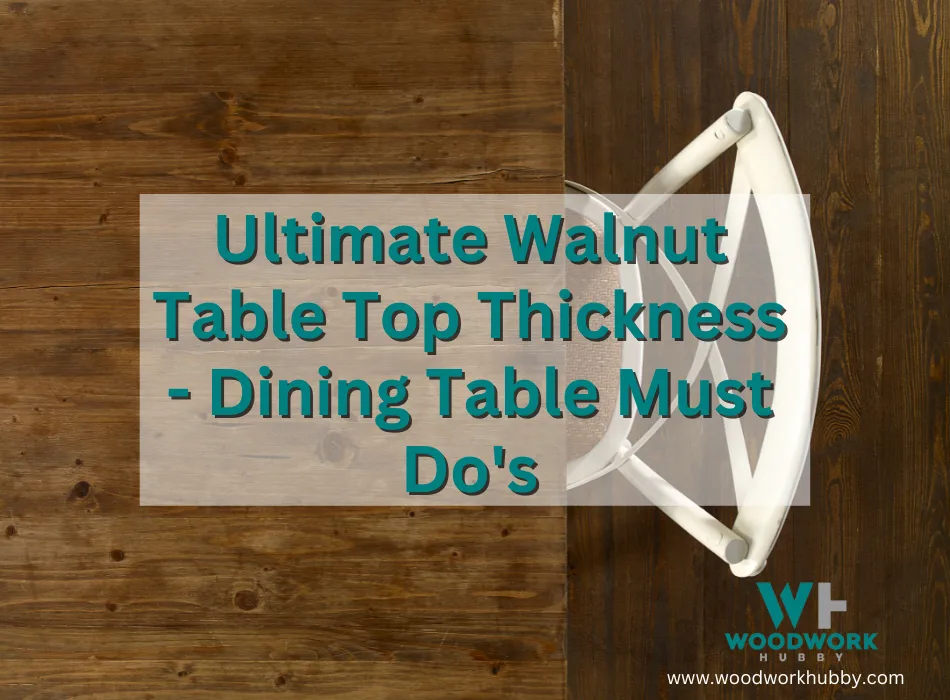Just last month, I was commissioned to build a walnut dining table for a family friend and they asked me how thick the top would be. I thought this was a great question as thickness brings not only strength but character. I’ve put together this informative guide to help you make the right decisions for the ultimate tabletop thickness.
In general, a walnut table top thickness should be at least 1 inch (25mm), which provides the best balance between strength and looks. You can also make it 32 or 45 mm if you want a more solid look. If you use reclaimed wood, ensure that the thickness is at least 38 mm.
You can use various kinds of wood for your tabletop, but walnut is an excellent choice because it is strong and durable. You can also use reclaimed wood, a great option if you want to add character to your table.
Your dining table is one of the most important pieces of furniture in your home. It provides a place to eat meals and can also be used as a workspace or makeshift desk. Because of this, it’s important to choose the right tabletop thickness for your needs.
In this blog post, I will recommend the best walnut tabletop thickness. I will also discuss the benefits of walnut table tops and help you decide which thickness is right for you.
Be sure to check out my detailed article on The Truth About How Long Walnuts Last Outside!
How Thick Should a Wood Table Be?
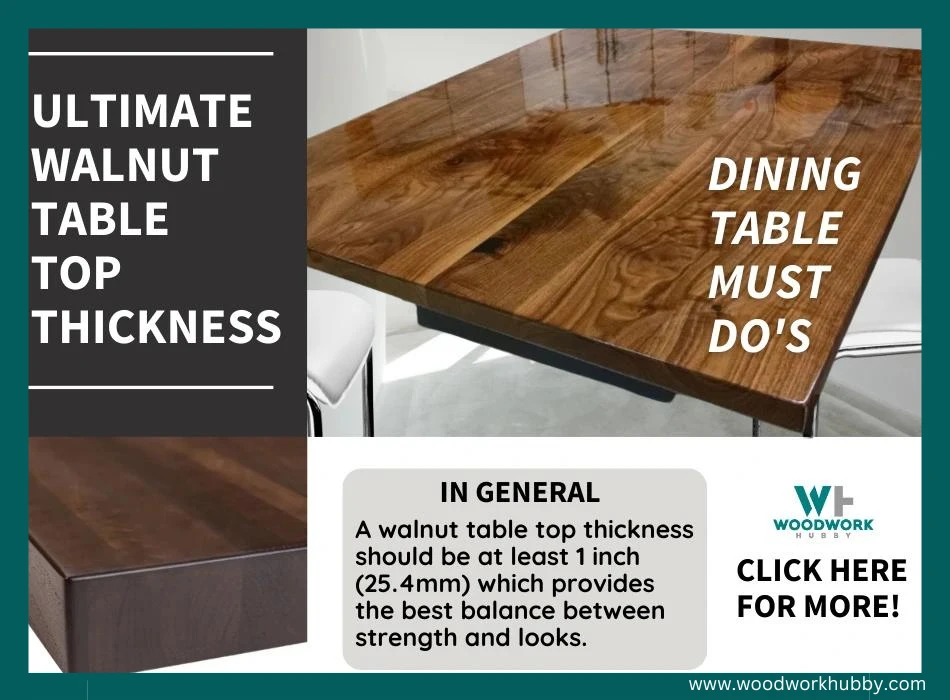
A wood tabletop should be at least 1 inch or 1.5 inches thick. However, if you want a more solid look, you can make it as thick as two or three inches. The thickness of your tabletop will depend on the type of wood you use and the style of your table.
The video shows Walnut Live Edge Slab Table.
If you are using reclaimed wood, I recommend using a thicker tabletop. This is because reclaimed wood is often thinner than new wood. A thickness of at least two or three inches will give your table a more solid look.
Read on as I dive deeper into what I found out on the topic Is Walnut Wood Food Safe? The Facts!
How Thick Should Walnut Table Top Be?
The thickness of your walnut tabletop should be based on the purpose of the table. If you plan to use the dining table, you will need a thicker tabletop. I recommend choosing a thickness of at least 25 mm for your walnut table top. You can also select a thickness of 32 or 45 mm if you want a more solid look.
A thinner tabletop will suffice if you plan to use the table as a workspace or makeshift desk. A thickness of 18 mm (0.70 in) is sufficient for this purpose. Reclaimed wood is a great option for tabletops. The minimum thickness for reclaimed wood tabletops is 38 mm (1.50 in). This type of tabletop can add character to your table and make it unique.
The width of the tabletop should be at least 1200 mm (47.24 in). This will give you enough space to work or eat comfortably.
Is Burning Walnut Wood Toxic? You Won’t Believe This! Here is my experience be sure to check it out!
Does Walnut Make a Good Tabletop?
Walnut is suitable for use because of its strength. When compared to other woods, walnut is stronger. This means that it can withstand more wear and tear. As you use your table, you may notice that other woods show signs of wear and tear. However, walnuts will remain strong for many years.
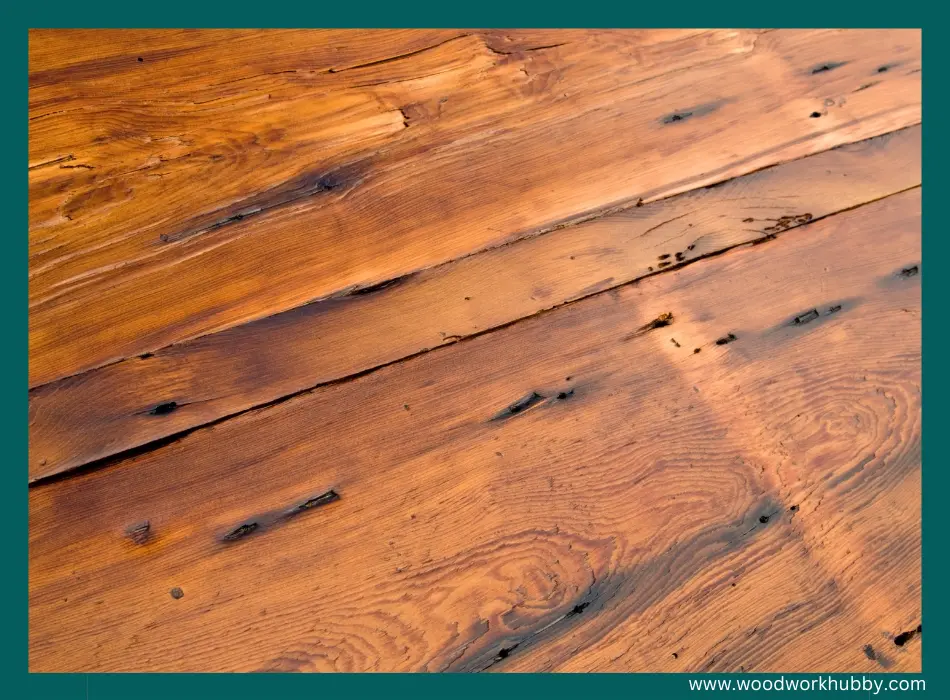
Other reasons include:
Durability
Durability is a central feature of walnut. When you use a walnut tabletop, you can be sure it will last many years. This is because walnut is resistant to water damage and scratches.
This means that it can withstand scratches, dents, and spills. If you have children or pets, you may consider using walnut for your tabletop because it is less likely to be damaged.
Easy to Maintain
Another reason walnut is an excellent choice for tabletops is that it is easy to maintain. You won’t have to spend hours sanding or polishing your tabletop.
A simple wipe with a damp cloth is all that is needed to clean walnut wood.
If you spill something on the tabletop, you can remove the stain with a mild cleaning solution. You won’t have to worry about damaging the wood by using the right cleaning products.
Unique
Walnut has a unique grain pattern that can add character to your table. No two walnut tables will look the same because of the variations in the wood grain. This makes each table unique and special.
Walnut is a beautiful timber but it is a good choice for a computer desk. See my article I wrote on the 15 best woods for computer desks.
Walnut tabletops can also add a touch of luxury to your home. They are available in various colors, including dark chocolate and rich caramel. Walnut table tops can also be stained to match your existing furniture.
Environment Friendly
If you are looking for an environmentally friendly option, consider using reclaimed wood for your tabletop. Reclaimed wood is recycled wood salvaged from old buildings or furniture. This type of wood is sustainable and can add character to your home.
Below is a table comparing the different strengths of wood.
| Wood | PSI |
|---|---|
| Walnut | 7580 |
| Maple | 7830 |
| Oak | 7440 |
| Cedar | 4560 |
| Mahogany | 6460 |
I decided to investigate further whether Can Walnut Wood Cause Allergies. Nut Allergy Truth. Here is what I found out! Click here to learn more!
Does the Size Affect the Thickness of the Top?
Yes, the size of the tabletop will affect the thickness. A larger tabletop will need to be thicker to support the weight. I recommend choosing a thickness of at least 25 mm (0.98 in) for large tabletops.
You can also choose a thinner tabletop if you plan to use it as a workspace or makeshift desk. A thickness of 18 mm (0.70 in) is sufficient for this purpose. The width of the tabletop should be at least 1200 mm (47.24 in). This will give you enough space to work or eat comfortably.
How Thick Should a Slab Table Top Be?
Slab thickness varies from 1″ to over 3″. The average thickness is usually between four and six inches. The type of wood will also affect the thickness of the slab. Harder woods like maple or oak will be thicker than softer woods like cedar.
The video shows tips for buying wood slabs.
The purpose of the table will also affect the thickness of the slab. A dining table will need to be thicker than a coffee table. I recommend choosing a thickness of at least two inches for a dining table.
Is a Thick Top Better Than a Thin One?
Now that you know the different thicknesses available, you may wonder if a thicker top is better than a thinner one. The answer to this question depends on your needs.
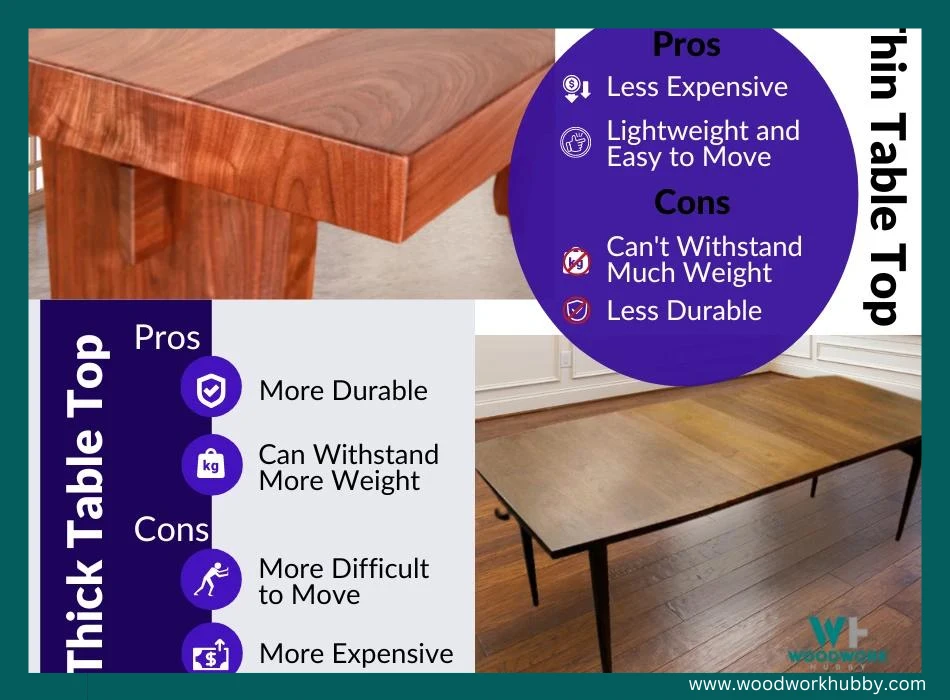
Read on as I discuss the benefits of the thick and thin tabletop.
Pros of a Thick Tabletop
A thick tabletop comes with the following advantages:
Can Withstand More Weight
If you plan to use your table for dining, you will need a thick tabletop. A thick tabletop can support the weight of plates, bowls, and other dinnerware. It can also accommodate multiple people without sagging in the middle.
More Durable
A thicker tabletop is also more durable than a thinner one. It is less likely to warp or crack over time. A thicker tabletop can also withstand more wear and tear.
Cons of a Thick Tabletop
A thick tabletop also has a few drawbacks:
More Expensive
Thicker tabletops are usually more expensive than thinner ones. This is because they require more wood to make. If you are on a budget, you may want to choose a thinner tabletop.
More Difficult to Move
A thick tabletop can be difficult to move around your home. If you plan to use your table in multiple rooms, you may want to choose a thinner option.
Pros of a Thin Tabletop
The thin tabletop also has its own set of advantages:
Less Expensive
As mentioned earlier, a thin tabletop is usually less expensive than a thick one. This makes it a great option if you are on a budget.
Lightweight and Easy to Move
A thin tabletop is also lightweight and easy to move around your home. You can easily carry it from one room to another.
Cons of a Thin Tabletop
Despite its advantages, a thin tabletop also has a few drawbacks:
Less Durable
A thin tabletop is not as durable as a thick one. It is more likely to warp or crack over time. You may need to replace it sooner than you would with a thicker tabletop.
Can’t Withstand Much Weight
A thin tabletop cannot support as much weight as a thick one. It is not ideal for dining tables or other areas where heavy objects will be placed on them.
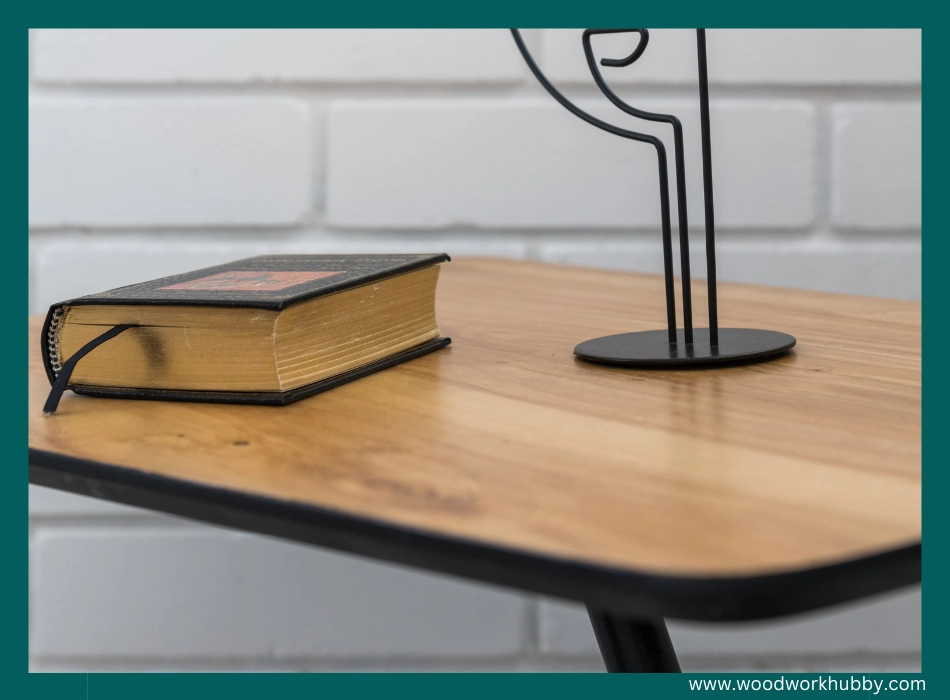
Choosing the Right Walnut Table Top Thickness for You
When it comes to choosing the right tabletop, there are many factors that you need to consider. The most important factor is the thickness of the tabletop. The thickness of the table top will determine the durability of the table. If you use reclaimed wood, ensure the thickness is at least 38 mm (1.50 in).
Other factors include:
Type of Furniture
Furniture has different thickness requirements. If you are creating a dining table, make sure the thickness is at least 25 mm to support the weight of plates and silverware. If you are making a coffee table, you can choose a thinner tabletop.
Leg Width
A dining table with a 3″ thick top and 4 1/2″ wide legs will feel strange and out of balance. Everything fits into place when those same wide legs are placed beneath a top that is 1 3/4″ thick.
Match your top’s thickness to the size of your table’s legs for ideal visual equilibrium. You will often want a slimmer top to match if your table legs are on the thinner side. This will produce a balanced look. Similar to how a thicker top looks better on legs that are on the wider side.
Style of Table
Some table styles require a thicker tabletop than others. A traditional table will have a thickness of around 18 mm, while a modern table may have a thickness of 25 mm or more.
Purpose of Furniture
The purpose of the furniture will also affect the tabletop thickness. A coffee table that will be used for storage will need to be thicker than one that is only used for display.
Edging
Edging (with a router) is when you round over the sharp edges of a board. This gives the furniture a softer look. Edging will also make the table top thinner. A table with a live edge will be thicker than one with a straight edge.
Budget
Budget is another important factor to consider when choosing the right tabletop thickness. Thicker tabletops are usually more expensive than thinner ones. If you are on a tight budget, you may want to choose a thinner option.
How Thick Should a Coffee Table Top Be?
The thickness of a coffee table top varies depending on the style of the table. A traditional coffee table will have a thickness of around 18 mm. A modern coffee table may have a thickness of 25 mm (0.98 in) or more.
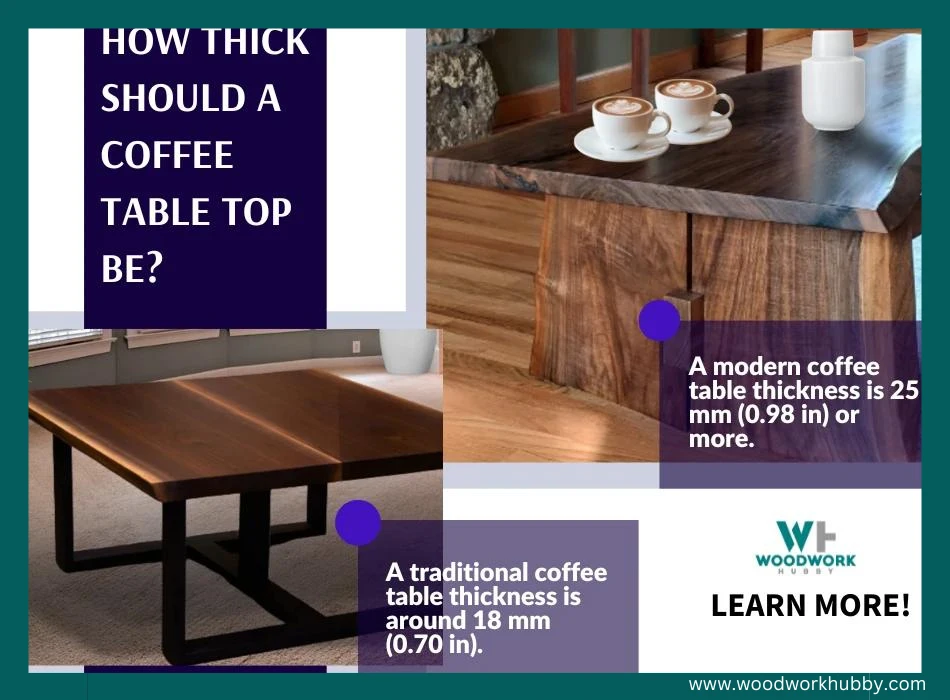
The type of wood will also affect the thickness of the tabletop. Harder woods like maple or oak will be thicker than softer woods like cedar.
I recommend choosing a thickness of at least 25 mm (0.98 in) for a coffee table that will be used for storage.
The purpose of the table will also affect the thickness of the tabletop. A coffee table that will be used for storage will need to be thicker than one that will only be used for display.
Ultimate Walnut Table Top Thickness | FAQs
How thick should a dining table top be?
The thickness of a dining table top should be at least 25 mm (0.98 in) to support the weight of plates and silverware.
What is the difference between a live edge and a straight edge table?
A table with a live edge will be thicker than one with a straight edge.
What is the best wood for tabletops?
The best wood for tabletops depends on the purpose of the table. If you are looking for a durable option, choose a harder wood like maple or oak. If you are looking for a more budget-friendly option, choose a softer wood like cedar.
Final Thoughts – Ultimate Walnut Table Top Thickness
The dining table top thickness needs at least 25 mm (0.98 in) to support the weight of plates and silverware. A table with a live edge will be thicker than one with a straight edge. The best wood for tabletops depends on the purpose of the table.
You should also consider the style of the table and the budget when choosing the right tabletop thickness. I hope this article was helpful in deciding what thickness you need for your next tabletop project. If you have any questions, feel free to leave a comment below. I would love to hear from you.

